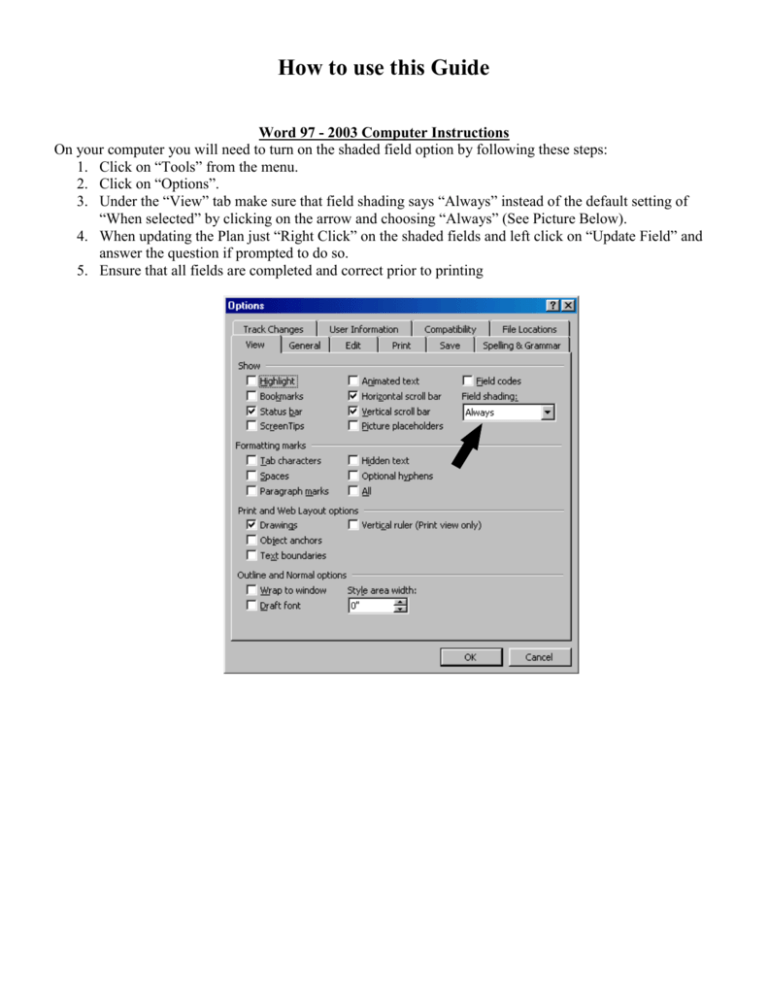Flushing Plan Template - Tennessee Association of Utility Districts
advertisement

How to use this Guide Word 97 - 2003 Computer Instructions On your computer you will need to turn on the shaded field option by following these steps: 1. Click on “Tools” from the menu. 2. Click on “Options”. 3. Under the “View” tab make sure that field shading says “Always” instead of the default setting of “When selected” by clicking on the arrow and choosing “Always” (See Picture Below). 4. When updating the Plan just “Right Click” on the shaded fields and left click on “Update Field” and answer the question if prompted to do so. 5. Ensure that all fields are completed and correct prior to printing How to use this Guide Word 2007 Computer Instructions On your computer you will need to turn on the shaded field option by following these steps: 1. Click on the “Office Button” in the top left corner. 2. Click on “Word Options”. 3. Click on “Advanced” on the left side of the window. 4. Scroll down to the “Show document content” section. 5. “Field shading” should show “Always”. If not, click the arrow and choose this option. 6. Ensure that all fields are completed and correct prior to printing Step 1 Step 2 Step 3 Step 45 Flushing Program Plan For Tennessee Association of Utility Districts I. Goal The purpose of the flushing program is to provide a safe high quality water supply to the customers of the Tennessee Association of Utility Districts. Debris can enter and accumulate in a water distribution system. Disinfectant residuals can deplete due to low usage and disinfectants may combine with materials in the system to form undesirable byproducts. Each of these situations may be corrected by an adequate flushing program. II Flushing points The following points should be used for flushing the distribution system: III. Plan of Action 1. A systematic flushing of the entire distribution system will be conducted annually or more often if required to maintain water quality. Individual sites will be flushed as needed. The flushing program will ensure that: a. b. c. d. Dead end and low usage mains are flushed periodically Drinking water standards are met Sediment and air are removed The required free chlorine residual is maintained 2. In some instances specific areas of the distribution system may need to be flushed more frequently to correct problems. These problems may include but are not limited to the following: a. b. c. d. Air in the lines Sediment in the lines Maintaining the free chlorine residual Taste, odor or color problems 3. Flushing will be performed by water system personnel and local firemen. 4. Following line repairs, main lines will be flushed to remove air and sediment from the repaired section of line. If disinfection is necessary to comply with the district’s Leak Repair SOP, the line will be flushed to remove the high chlorine content. During flushing, water containing high chlorine concentrations will be flushed on relatively flat ground so as not to contaminate a receiving stream or body of water. 5. Flushing should continue until the following conditions are met: a. b. c. d. The free chlorine residual reaches a minimum of 1.0 mg/l No air is detected Water is clear with no visible sediment No objectionable taste or odor remains 6. Flushing will be performed so as to ensure a minimum velocity of 2 fps to adequately scour the interior of the main. IV. Record Keeping Records of each flushing will be maintained by the Tennessee Association of Utility Districts. These records will include the following: A. Date B. Time C. Location D. Persons responsible E. Length of flushing F. The free chlorine residual after flushing dead end mains G. Other information deemed as useful to the Tennessee Association of Utility Districts Tennessee Association of Utility Districts Flushing Report DATE HYD. NO. LOCATION START TIME STOP TOTAL TIME MIN. FLOW TOTAL STATIC Cl2 RES. Cl2 RES. G.P.M. FLOW GAL. P.S.I. BEFORE AFTER COMMENTS INITIALS



